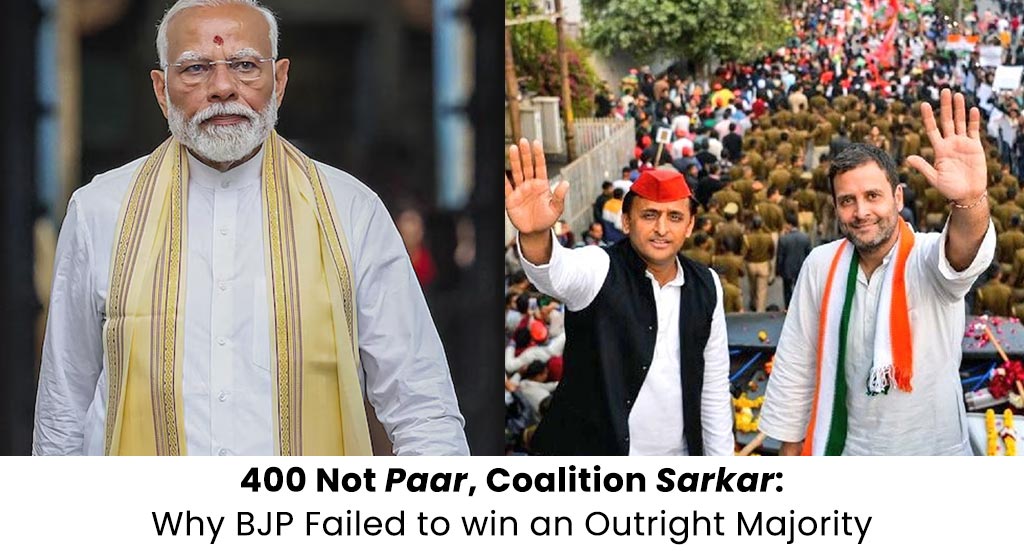For the first time since coming to power in 2014, the Bhartiya Janata Party has failed to secure a majority on its own in the general elections. The right-wing party won 241 seats in the 543-member house – slightly short of the 272 majority mark – while its allies secured 53 seats, which makes the formation of the government dependent on NDA partners TDP and the JD(U) led by Chandrababu Naidu and Nitish Kumar, respectively. BJP leader and two-time Prime Minister Narendra Modi has been “unanimously” elected as the leader of the NDA alliance, the BJP announced on June 5.
Led by Congress leader Rahul Gandhi, the INDIA bloc – an alliance of opposition parties formed to challenge PM Modi-led National Democratic Alliance (NDA) settled at a final tally of 232 seats. INDIA leaders have rushed to Delhi, plausibly to discuss efforts to form a government.
In 2019, the BJP won 303 seats on its own account while the NDA clinched 353 seats. So, what went wrong for the saffron party this time? Narendra Modi’s “Ab ki baar, 400 paar,” slogan aiming for more than 400 seats for his NDA alliance, seems to have backfired, with such a massive majority raising fears of constitutional changes among the poor. Here are 7 other crucial factors that seemingly didn’t work for the BJP this time.
1. The UP Stunner
The biggest shocker among all the states for the BJP comes from Uttar Pradesh, where the INDIA bloc won 43 of the 80 seats, reducing the BJP’s share to 33 in the bellwether state. Akhilesh Yadav patiently built an opposing narrative to the BJP’s Hindutva pitch for nearly two years. He rallied around him backward castes like the Mauryas, Kushwahas, Pal, and Nishad communities, not to forget the Dalits whereby the party fielded two SC candidates, a Pasi and a Jatav, from general seats. Akhilesh also aligned with the Congress to capitalise and maximise the Muslim vote and kept the Yadav clan together by addressing the ego of his uncle Azam Khan. Yogi Adityanath’s advice on ticket distribution was also not adhered to, which is being seen as another factor for the BJP’s slip in performance in the state, which accounts for the largest number of seats in the Lok Sabha.
According to analysts, another reason for the BJP’s poor show in Uttar Pradesh was its focus on big rallies of PM Modi, Yogi Adityanath, and Home Minister Amit Shah. In contrast, Congress general secretary Priyanka Gandhi focused on regular (daily) meetings with smaller groups of people.
2. OBC Politics
OBCs are the single-largest community of voters in several states, including Uttar Pradesh, Haryana, and Maharashtra, where the BJP has lost voter share. The Opposition narrative that the BJP would alter the reservation provision for OBCs in government jobs and higher education seems to have reaped dividends. The Congress and the other parties of the INDIA bloc assured they would replicate the Bihar model of caste survey all over the country. Meanwhile, in Bihar, the BJP did not perform as poorly because NDA ally and JD(U) president Nitish Kumar had got the caste survey done in the state.
3. A United Opposition
The Opposition didn’t have a national coalition in the 2014 and 2019 elections. An Opposition bloc poses a serious threat to any ruling party or coalition given that in India no party has ever come to power at the centre with a vote share of over 50% vote. In the 2019 election, the BJP-led NDA secured 45% votes, implying that 55% of those who cast their votes did not go with the ruling coalition. This time, the INDIA bloc coalition emerged as a viable alternative to the anti-BJP voters in the general election. The TMC, CPM, and AAP contested against the Congress in their strongholds of West Bengal, Kerala, and Punjab, respectively, but presented a united front against the BJP on more than 200 Lok Sabha seats.
4. Ram Mandir Campaign
The BJP was banking upon the fulfilment of its promise to build a Ram Mandir in Ayodhya for winning votes. However, ironically, for the party, it lost the Faizabad seat where Ayodhya, the seat of the temple, is situated. Of the seven seats bordering Faizabad, the Congress was ahead in 2, the SP in 3, and the BJP in 2.
5. Anti-Incumbency
PM Modi’s larger-than-life stature seems to have taken a dent, indicating that even the charismatic Indian leader is vulnerable to anti-incumbency, offering renewed hope to the INDIA bloc.
6. Inflation & Unemployment
The results of a survey conducted by Lokniti-CSDS throughout the polling period reveal that 30& of the voters were worried about inflation. The agency spoke to around 20,000 voters across 23 of the 28 states in India. In an earlier survey conducted before the election. 32% of the respondents were concerned about unemployment.
7. The Agnipath Scheme
The Agnipath scheme for recruiting soldiers clearly didn’t work for the BJP, as is evident from the dent in its performance in Rajasthan and Haryana, two states that send a sizeable number of youths to the defence and paramilitary forces. Rahul Gandhi was very vocal in his criticism of the Agnipath scheme.
The BJP had won all 10 seats in Haryana in 2019, while this time around, the saffron party led in five seats while the Congress was ahead in five other seats. The drop in performance was evident in Haryana, where the party had won all 25 seats in 2019, but it led in only 14 seats this time. The Congress was ahead in eight seats.








